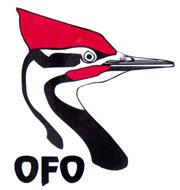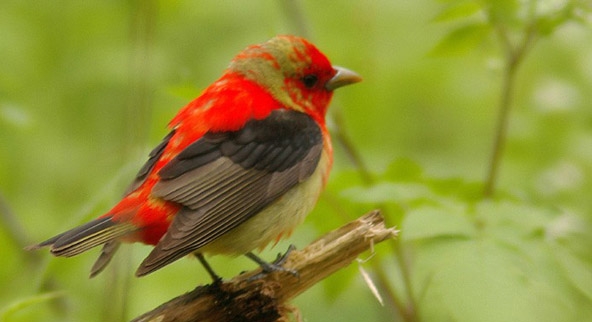| General Terms | Plumages | Molts |
| Banding Codes | Humphrey and Parkes Terminology | One or Two Molts? |
| Two Main Types of Molt and Plumage Sequences | Comparison of Plumage and Molt Terminologies | Recommendations |
Plumage and Molt Terminology
By Ron Pittaway
Published in Ontario Birds 18(1):27-43 in April 2000
A knowledge of plumages, molts and ageing is essential to the modern birder. The identification of a rare gull or shorebird often hinges on knowing its correct plumage and stage of molt. Determining a bird‘s plumage and molt is an identification challenge that will add new fun and skills to your birding. It is also important to translate correctly between different terminologies. This article (1) defines the key general terms of plumage and molt, including the banding codes; (2) provides separate lists of birds that molt once and twice per year; and (3) compares a general terminology with that of Humphrey and Parkes (1959). The Humphrey and Parkes terminology is recommended where there is a need to describe precisely a bird's plumages and molts.
Please contact Ron if you have further questions. Ron Pittaway, 9 Lichen Place, Toronto ON M3A 1X3, tel (416) 445-9297, or
General TermsTop
The following terms are used commonly by North American birders, but they are often used inconsistently by authors and birders. Here, each term is given an exact meaning in an attempt to standardize the definitions. Plumage terms are defined first, followed by the terms for molt.
PlumagesTop
Immature
A general and collective term that includes juvenile, first winter, first summer and all subsequent plumages until the non-changing adult (definitive) plumage is acquired.
Juvenile or Juvenal
To avoid confusion, it is best to use these two terms as having the same meaning. It is the first covering of true contour feathers following the natal down(s), or in certain species it succeeds the naked nestling stage without the natal down. Juvenile has a precise meaning; it is the first immature plumage. The juvenile plumage is worn briefly in most passerines, but much longer in loons, hawks, gulls, shorebirds and others. In most birds, the juvenile feathers appear looser, woollier, and differently coloured and shaped than subsequent stages. Some authors use juvenile, but not juvenal, as having the same meaning as immature, just adding to the confusion. Other authors use juvenile as a noun and juvenal as an adjective. For example, the juvenile is in its juvenal plumage. However, both words can be used as nouns and adjectives. See also the definition of Juvenal in the section below under the Humphrey and Parkes terminology.
First Year
This term applies to birds that molt once per year. It follows the postjuvenile molt and is retained until the first postbreeding molt. First year birds do not have separate first winter and first summer plumages. In many birds, first year plumage is worn from late summer or early fall to the following summer. First year plumage is adult-like in many species, especially passerines. Many breed in this plumage. First year birds often can be separated from adults by retained juvenile feathers. See the sections on Feather Generations and Ageing below. First year is also used as a general term to include birds in juvenile, first winter and first summer plumages.
First Winter
This is also called first nonbreeding plumage. First winter plumage follows the postjuvenile molt in birds having two plumages a year. First winter plumage is retained until the first prebreeding molt. First winter is adult-like in some species, but many other species are separable from adults in the field. See also the sections below under Feather Generations and Ageing.
First Summer
This term does not refer to a bird in the summer of its hatching year, but to the next summer in its second calendar year. Remember this point to avoid confusion. It refers to that plumage following the first winter plumage in birds having two plumages a year. It is acquired by the first prebreeding molt and retained until the first postbreeding molt. First summer plumage is adult-like in most species. Most passerines breed in first summer plumage, but they are not adults because they retain juvenile flight feathers. Many first summer birds are separable from adults in the field by their duller or incomplete plumage colour and molt contrast. See the sections below under Feather Generations and Ageing. First summer is sometimes called first breeding plumage. When you are unsure if the bird is in first summer or adult breeding plumage, just call it breeding plumage to include both age classes.
Second/Third Winter
Some birds that have two molts per year, such as large gulls, have recognizable second and third winter plumages.
Second/Third Summer
Some birds that have two molts per year, such as large gulls, have recognizable second and third summer plumages.
Second/Third/Fourth Year
Some species have recognizable second, third and fourth year plumages.
Adult
Adult refers to a bird's plumage, not to whether the bird is of breeding age. A bird is adult when it acquires its final or definitive plumage that is then repeated for life. Birds that molt once a year have only one adult plumage; they are not divided into adult winter and adult breeding plumages. The sexes are often alike in birds having only one adult plumage and many are dull and cryptic in colour. Birds that molt twice per year have two adult plumages: adult winter and adult breeding. The sexes are often different, particularly the breeding plumage, in species having two adult plumages. Most passerines breed in their second year before they acquire adult plumage; they appear very adult-like but retain the juvenile flight feathers. Accipiter hawks frequently breed in their second year when they are in juvenile plumage. They are “adults” only in terms of reproduction, but not plumage. Birds wearing any retained immature plumage, even though breeding, are not adults. Note: “adult” used here is synonymous with the term definitive of Humphrey and Parkes.
Adult Winter
Birds that molt twice per year have two adult plumages: adult winter and adult breeding. Adult winter plumage is also called adult nonbreeding plumage.
Adult Breeding
Birds that molt twice per year have two adult plumages: adult breeding and adult winter. Adult breeding plumage is also called adult summer plumage, and in the old literature it was known as adult nuptial plumage. In adult birds that have two distinct plumages, adult breeding and adult winter, there are a very few species where the sexes have identical plumages (e.g., loons).
Subadult
This is generally used to describe birds whose plumage is nearly adult in appearance, but shows traces of immaturity. It is most often used for birds that take several years to reach adult or definitive plumage, such as eagles. This term is confusing and is best avoided.
Eclipse
This female-like plumage is held very briefly by ducks in summer and early fall, and is most noticeable in the males. Eclipse is really the basic or winter plumage, but is worn in summer by most ducks, except the Ruddy Duck which wears eclipse to late winter. Most ducks acquire breeding plumage in the fall, six or seven months before other birds. This shift in the assumption of breeding plumage appears related to courtship during fall and winter.
Calendar Year Terminology
First calendar year refers to a bird up to the 31 December of its hatching year. Second calendar year goes from 1 January to 31 December, and so forth. Large birds, such as eagles, are often aged using the calendar year.
MoltsTop
Traditional molt terms are postjuvenal or postjuvenile, prebreeding and postbreeding. These terms are defined below. Complete molts replace all the feathers, sometimes interrupted by a pause between periods of molting. Anything less than a complete molt is termed a partial molt. Most partial molts replace the body feathers, but not the wings and tail. Some partial molts are limited, usually replacing only a few head and/or body feathers. Depending on the species, molts may be protracted such as in hawks, or suspended during migration and continued (offset) on the wintering grounds.
Postjuvenile Molt
This begins soon after fledging in most passerines and somewhat later in many nonpasserines. It is a partial molt in most birds, producing first winter and first year plumages. A very few species have a complete postjuvenile molt. These species usually acquire adult plumage directly from the juvenile plumage; for example, the Horned Lark becomes an adult at about three months of age.
Prebreeding Molt
Some species have a molt in late winter or early spring that produces a separate, often more colourful, breeding or summer plumage. It is a partial molt in most species. A very few species, such as the Bobolink, have a complete prebreeding molt.
Postbreeding Molt
This is the complete annual molt found in nearly all species. In many species, this is the only yearly molt. It occurs after the breeding season in most species, but in other species it starts much earlier or later. In some species, the postbreeding molt takes place on the wintering grounds after migration. It produces a combination winter and summer (yearly) plumage in species that molt once per year. In species that molt twice per year, it produces the winter plumage. During the postbreeding molt, there is often a noticeable change in the behaviour of many birds, particularly in passerines; they become quiet and lethargic, avoiding long flights, and spending more time resting and skulking. Knowing differences in the timing of molts among similar species can help identify a difficult species; for example, some Empidonax flycatchers molt before, and others after, fall migration.
Feather Generations
The feathers acquired by a molt, whether partial or complete, form a feather generation. Most first winter and first year birds wear a combination of older juvenile and newer first winter feathers. First summer shorebirds often wear a combination of old juvenile, somewhat younger first winter and new first summer feathers. Most adult birds that molt twice per year are wearing two feather generations during the nesting season. Juvenile, first year, first winter, first summer and adult feathers often have different patterns, colours, shapes, lengths and amount of wear. Being able to recognize different feather generations is one of the keys to understanding molt. Practice on photographs, feeder birds, birds in the field and even dead birds, but do not keep them unless you are giving them to a museum. A visit to a museum or university collection is very instructional.
Ageing
Age and plumage terms often have the same meaning. Adult, juvenal, first summer, second winter and so forth are terms that have both plumage and age meanings. However, a Herring Gull in adult winter (definitive basic) plumage could be as young as 3.5 years in its first adult plumage or it could be 25 years old because its adult plumages change little with time. Many passerines in adult-like plumage, especially males, can be aged as first year, first winter and first summer by the molt contrast between their retained, browner juvenal flight feathers and the newer blacker remainder of the wing. Examples of the latter are first summer male Rose-breasted Grosbeak (see Figure 1) and Black-headed Grosbeak, first summer male Western Tanager and Scarlet Tanager (see Figure 2), and first year male Eastern Towhee and Spotted Towhee.
Feather contrasts can also be noted in dull species (e.g., sparrows), but one must have a close look and considerable experience. This is an area where birders can greatly expand their knowledge. See Pyle (1997) for detailed information on ageing. Finally, many species cannot be aged exactly in the field.
Feather Wear
In time, feathers become frayed and faded and the bird is in worn plumage. Species that molt once a year in late summer and breed the following spring do so in worn plumage. The Eastern Towhee is a species in which the changes due to wear are rarely noticeable in the field. Some species, however, dramatically change their appearance and acquire their breeding dress by wearing off the tips of their feathers. The effects of feather wear on the changing seasonal appearance of birds are sometimes mistaken for molt. Early ornithologists called this “molt by wear”. The European Starling, House Sparrow and blackbirds are examples of species that have quite different fall (fresh) and spring (worn) appearances, but they have the same feathers. The Snow Bunting is an extreme example of changing its winter to summer appearance by feather breakage. In early spring, the brown feather tips break off as if cut by scissors, exposing a striking black and white breeding dress. The Snow Bunting attains the functional equivalent of a breeding plumage without molting; there is a very limited molt of some facial feathers, but this is inconsequential. The other extreme is the male Bobolink, which has a complete prebreeding molt. In very fresh breeding plumage, it is clouded over with buff, which soon wears off. In most cases, the fresh plumaged birds in the fall are duller because of gray or buffy feather margins that wear off gradually, exposing a somewhat brighter or darker plumage by spring. However, a few species are actually brighter in fresh fall feathering becoming duller by spring (e.g., Grasshopper Sparrow).
Confusing Terms
Some books use seasonal descriptions for plumages and molts. Examples are fall plumage, spring plumage, summer molt and so forth, but these are not official terms. They simply refer to the time of year a plumage or molt occurs. Immature ducks in winter also cause problems with plumage names because most are in the homologous equivalent of breeding plumage. Eiders are often labeled as “first winter” in field guides when in fact they are molting or in first summer (alternate) plumage that is worn in winter! The European literature often uses first summer, second summer and so forth for birds that acquire their summer appearance by wear only. Do not assume that the plumage labels in field guides and birding journals are correct.
Banding CodesTop
Bird banders use an age code that is linked to the calendar year. This code is used by the Canadian Wildlife Service and the United States Fish and Wildlife Service.
HY
(hatching year) is for a bird up to and including the 31 December of the calendar year in which it was hatched. It includes birds in juvenile, first winter and first year plumages. Banders sometimes use the label Juv for birds that are clearly in juvenile plumage, but this use is not officially part of the code.
AHY
(after hatching year) is for a bird in at least its second calendar year or older. Year of hatch is unknown, but it is at least a SY.
SY
(second calendar year) is for birds in their second calendar year from 1 January to 31 December. These birds are known to have hatched in the preceding calendar year.
ASY
(after second year) is for a bird in at least its third calendar year. Year of hatch is unknown.
TY
(third year) is for a bird known to be in its third calendar year.
ATY
(after third year) is for a bird (normally adult) in at least its fourth calendar year. Year of hatch is unknown.
U
(unknown) is for a bird after the breeding season and before 1 January that cannot be placed in any of the age classes below. After 31 December use AHY.
L
(local) is for a young bird incapable of sustained flight. Banders sometimes label these birds as Juv (juvenile), but it is not part of the official code.
Humphrey and Parkes TerminologyTop
The molt and plumage terminology of Humphrey and Parkes (1959) is used widely by North American ornithologists in the professional literature; for example, Palmer (1962, 1976, 1988) in the Handbook of North American Birds, and more recently in The Birds of North America series. The American Birding Association adopted Humphrey and Parkes as the standard in its journal Birding (Wilds 1989). In Canada, the Ontario Bird Records Committee uses the Humphrey and Parkes system in its annual reports published in Ontario Birds. The Humphrey and Parkes system can be used anywhere in the world because it is not linked to age, seasons or breeding cycle. It is a joy to use, once mastered.
Plumages
Plumages are named juvenal, basic, alternate and supplemental. A new plumage is acquired only by a molt. Many birds wear more than one generation of feathers simultaneously, but their plumage is always named after the last acquired generation. For example, a male Scarlet Tanager in definitive alternate (adult breeding) plumage retains its definitive basic (adult winter) wing and tail feathers. If males have a prealternate molt, the females also usually molt. But in the case of the Scarlet Tanager, the female in basic and alternate plumages is similar.
Juvenal
This is the first generation or coat of true contour feathers following the natal down or downs. Humphrey and Parkes (1959) retained the widely used term juvenal from the earlier North American literature. Juvenal refers to both the bird and its plumage; it is both a noun and an adjective. To avoid confusion, I recommend that juvenal and juvenile be used as synonyms. Use juvenal if you want to be sure of not being misunderstood.
Basic
The basic plumage usually follows the juvenal plumage. See discussion below under Supplemental for exceptions. In species that molt once a year, the basic is repeated as the only plumage. The sequence is juvenalmolt to basic molt to basic molt to basic, repeated for the life of the bird. In birds that molt twice a year, the basic plumage is one of two plumages: basic and alternate. Basic equals winter plumage only in birds that have an alternate plumage. Recognizable plumages may be numbered first basic, second basic and so forth to describe recognizable plumage stages until the definitive basic plumage is reached. Basic plumage is acquired by a prebasic molt. The first prebasic molt is a partial molt in most birds, replacing the body feathers, but usually not the wings and tail. The second and subsequent prebasic molts are complete in most birds, replacing all the feathers.
Alternate
This is the name of the second plumage for birds that molt twice a year: basic and alternate. The sequence is juvenal molt to basic molt to alternate molt to basic molt to alternate, repeated for the life of the bird. Alternate equals breeding or summer plumage. Recognizable plumages may be numbered first alternate, second alternate and so forth until definitive alternate plumage is reached. Alternate plumage is acquired by a prealternate molt, which is usually a partial molt in most birds, replacing only body feathers, but not the wings and tail. Alternate plumages are brighter and more colourful in many species, but in some the alternate is practically identical to the basic. Note: birds that molt once a year do not have an alternate plumage.
Supplemental
It was first defined as the name of the third plumage when there are three molts per year. The supplemental plumage precedes or follows the alternate, depending on the species. There are a very few species with more than two definitive (adult) plumages. It occurs in pelicans, Oldsquaw, ptarmigan and a few other species, and is acquired by a presupplemental molt. Note: We now know that supplemental plumages also occur in the first year of life in birds that later have only one or two molts per year. Some young birds acquire a supplemental plumage before and/or overlapping with the first prebasic molt. Examples are the Phainopepla, Yellow-breasted Chat, Passerina buntings and Northern Cardinal. These species have a previously unknown sequence of molts and plumages that are probably more frequent in other birds than currently known. The sequence for these species is juvenal plumage, presupplemental molt, supplemental plumage, first prebasic molt, and first basic plumage. Later supplemental stages are apparently absent. When a new molt and plumage are discovered, the procedure to name it is to equate one of the plumages with later basic plumages and to compare it with basic plumages in related species to determine which is the additional supplemental plumage. The uncommon supplemental plumage is not treated in the comparison chart below (Table 1).
Definitive
Definitive equals adult plumage, except that it is used only as an adjective. A bird can be an adult, but not a definitive! It is the final plumage that does not change further with age; all subsequent stages of the same plumage are identical. It is an adjective: definitive basic plumage, definitive alternate plumage, definitive supplemental plumage, and so forth. Definitive is also used to describe molts; for example, the definitive prebasic molt.
Predefinitive
This is a useful collective term with the same general meaning as immature defined previously. Predefinitive refers to all plumages before the definitive stage is reached. Molts also may be termed predefinitive. Humphrey and Parkes (1959) did not define predefinitive.
Molt Names
Molts are named in terms of the incoming plumage: prebasic molt, prealternate molt and presupplemental molt. The following are some examples of how to describe a bird in molt: (1) the juvenal Bonaparte's Gull is beginning its first prebasic molt; (2) the male Scarlet Tanager is ending its definitive prealternate molt; and (3) the Stilt Sandpiper is in the middle of body molt from juvenal to first basic plumage, or you could say that it is in juvenal/first basic plumage. It is incorrect to say a bird is in its prebasic plumage or prealternate plumage because these terms refer to molts, not to plumages.
Molt Equivalents
First prebasic molt equals postjuvenile molt, but note that the second and later prebasic molts equal postbreeding molts. Prealternate molt equals prebreeding molt. Humphrey and Parkes (1959) did not originally apply the term definitive to molts, but it is now used for the molts leading to definitive plumages. They are now called the definitive prebasic molt, definitive prealternate molt and definitive presupplemental molt.
Molt Patterns
Some of the information described below has been repeated from earlier sections for clarity. Molting includes both the shedding and replacing of a bird's feathers. Regular molts in birds are necessary because feathers wear out with time, becoming less effective for insulation and flight. The juvenal (juvenile) is the first plumage acquired after the natal down. The young bird then goes through a series of molts and plumages until definitive (adult) plumage is attained. There are four main molt strategies in definitive (adult) birds:
1. A complete molt renewing all feathers once a year, usually in late summer or early fall after the breeding season. This is called the definitive prebasic (adult postbreeding) molt.
2. Many other species have a complete molt as in (1) plus an additional partial molt of the head and body feathers, usually in late winter or early spring, acquiring definitive alternate (adult breeding) plumage. This is called the definitive prealternate (adult prebreeding) molt. Prealternate molts may have evolved in some species to produce a colourful courtship and breeding appearance. The vast majority of birds use molt strategies (1) or (2) above. The primaries, secondaries and tail of most birds are molted only once per year during the complete molt.
3. A very few species, such as the Bobolink, have two complete molts per year.
4. The Oldsquaw and a few other species have three molts per year; the third partial molt is called the presupplemental molt, leading to the supplemental plumage. See discussion above under Supplemental. Note: In birds that develop brood patches, the feathers are shed out of phase with the rest of the plumage.
Cycle
In definitive (adult) birds, a cycle is the time period that runs from a given plumage or molt to the next occurrence of the same plumage or molt. The number of molts and plumages equals the maximum number of times any feather follicle is normally activated. The basic plumage is commonly taken as the start of a plumage cycle. A cycle is a year in most temperate zone species, but shorter in some oceanic and tropical species. Cycles longer than a year are few. A cycle often straddles two calendar years. Most birds have either one basic plumage and one prebasic molt per year, or two plumages (basic and alternate) and two molts (prebasic and prealternate) per year. For example, a Horned Lark has only a basic plumage per year, and a Scarlet Tanager has two plumages, basic and alternate, per year.
Application
The Humphrey and Parkes system also can be used with Roman numerals, but capitalize the names of plumages and molts; for example, Alternate II plumage, Prebasic I molt and so forth. As well, some terms can be abbreviated but also must be capitalized; for example, Def. Basic plumage, Def. Alt. plumage, Def. Suppl. plumage, Alt. I plumage and so forth. The terms Basic and Prebasic are not abbreviated. Note that prebasic, prealternate, and presupplemental are molts not plumages. For example, birds do not have “prebasic plumages”. Also, try not to mix terminologies, but adult alternate plumage, adult prebasic molt, adult in basic plumage and adult in prealternate molt and so forth are now widely used.
One or Two Molts?Top
Most birds molt either once or twice a year. Knowing whether a bird molts once a year or twice a year is the key to determining its plumage and age. For example, adult birds that molt once a year have only one definitive (adult) plumage, called the definitive basic. Birds that molt twice a year have two definitive plumages: definitive basic (adult winter) and definitive alternate (adult breeding). Information below on the number of molts is based mainly on Oberholser (1974) and Pyle (1997).
One Molt
The following list applies only to those North American birds found north of Mexico. They have one molt and therefore one plumage per year. After the juvenal plumage, they molt from basic to basic, repeated as the only plumage. Any changes in appearance are caused by wear (loss of feather fringes) and fading in some species. In a few species, the change in appearance between fresh and worn plumage is striking, but these are not separate plumages. Birds that have one molt are: albatrosses; shearwaters and petrels; storm-petrels; tropicbirds; boobies and gannets, except Northern Gannet; frigatebirds; New World vultures; whistling-ducks; geese and swans; ospreys; kites, eagles and hawks; caracaras and falcons; Plain Chachalaca; partridges and pheasants; grouse, except ptarmigans; turkeys; jacanas; pigeons and doves; parrots; New World cuckoos; roadrunners; anis; owls; goatsuckers; swifts; hummingbirds; trogons; Eurasian Hoopoe; kingfishers; woodpeckers; some tyrant flycatchers, including Olive-sided Flycatcher, Greater Pewee, Western Wood-Pewee, Eastern Wood-Pewee, Black Phoebe, Eastern Phoebe [see Pyle (1997) for exceptions]; some vireos, including White-eyed Vireo, Bell's Vireo, Hutton's Vireo, Red-eyed Vireo, Yellow-green Vireo and Black-whiskered Vireo; jays, Clark's Nutcracker, magpies, Eurasian Jackdaw, crows and ravens; larks; some swallows, including Purple Martin and Cliff Swallow; chickadees and titmice; verdins; bushtits; White-breasted Nuthatch; creepers; wrens, except Sedge Wren and Marsh Wren; dippers; kinglets; thrushes; Wrentit; catbirds, mockingbirds and thrashers; starlings; accentors; waxwings; Phainopepla; Olive Warbler; some wood-warblers, including Yellow-throated Warbler, Pine Warbler, Prothonotary Warbler, Worm-eating Warbler, Swainson's Warbler, Hooded Warbler, Red-faced Warbler, Painted Redstart and Yellow-breasted Chat [see Pyle (1997) for other species having an absent to limited prealternate molt]; bananaquits; some tanagers, including Hepatic Tanager and Flame-colored Tanager; some sparrows and buntings (Emberizidae), including towhees, Vesper Sparrow, Black-throated Sparrow, Sage Sparrow, Snow Bunting and McKay's Bunting; some cardinals and grosbeaks (Cardinalidae), including Northern Cardinal, Pyrrhuloxia, Blue Grosbeak (has first prealternate molt only) and Varied Bunting; most blackbirds, except Bobolink, and some orioles (have mainly first prealternate molt only); most finches, except goldfinches; and Old World sparrows. Note: Some birds listed above may have alternate and/or supplemental plumages that have not been detected. See Pyle (1997) for more information and exceptions to the above.
Two Molts
The following list applies only to those North American birds found north of Mexico. They have two molts and therefore two plumages a year, both basic and alternate plumages. These birds are: loons; grebes; Northern Gannet; pelicans; cormorants; darters; herons, bitterns and allies; ibises and spoonbills; storks; flamingos; shelducks; true ducks (Anatinae); ptarmigans; New World quail; rails, gallinules and coots; limpkins; cranes; lapwings and plovers; oystercatchers; stilts and avocets; sandpipers, phalaropes and allies; pratincoles; skuas, jaegers, gulls, terns and skimmers; auks, murres and puffins; Eurasian Wryneck; most tyrant flycatchers, including the genus Empidonax[see Pyle (1997) for exceptions]; shrikes; some vireos, including Black-capped Vireo, Yellow-throated Vireo and Warbling Vireo [see Pyle (1997) for details]; swallows (probably very limited prealternate molt in most species); nuthatches, except White-breasted Nuthatch; Sedge Wren and Marsh Wren; Old World warblers and gnatcatchers; Old World flycatchers; wagtails and pipits; most wood-warblers [see Pyle (1997) for exceptions]; some tanagers, including Summer Tanager, Scarlet Tanager and Western Tanager; most sparrows and buntings (Emberizidae); most Cardinalidae, including Rose-breasted Grosbeak, Black-headed Grosbeak, Blue Grosbeak (first prealternate molt only), Lazuli Bunting, Indigo Bunting, Painted Bunting and Dickcissel; some blackbirds, including Bobolink, and orioles (mainly first prealternate molt); and a very few finches, including goldfinches. Omitted from the above are some passerines whose prealternate molt is so very limited (e.g., a few head feathers) that little or no detectable change by molting occurs. Note: Some birds listed above may have a supplemental plumage that has not been detected. See Pyle (1997) for more information and exceptions to the above.
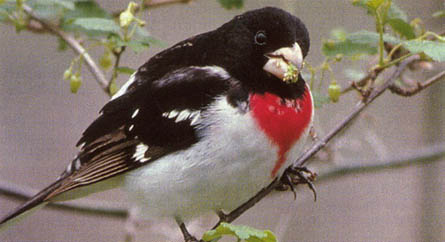
Figure 1: Male Rose-breasted Grosbeak in first alternate plumage told by retained juvenal brown instead of black primaries and secondaries. Photo courtesy of Point Pelee National Park
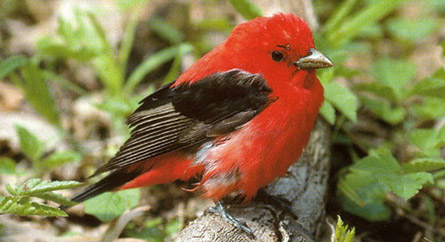
Figure 2: Male Scarlet Tanager in first alternate plumage told by retained juvenal brownish instead of blackish primaries and secondaries. Photo: Jim Flynn
Two Main Types of Molt and Plumage SequencesTop
Figures 3 and 4 are schematic colour illustrations by Peter Burke showing sequence of plumages in American Robin and Scarlet Tanager. Colour scheme: juvenal (gray), first basic (bronze), first alternate (orange), definitive basic (cinnamon), definitive alternate (purple). Corresponding plumages are the same colours in both American Robin and Scarlet Tanager, but robin lacks an alternate plumage. Colours are not actual, but represent different feather generations after each molt. Note retained feathers by the same colour as the previous plumage(s), usually wings and tail, following partial molts in first basic, first alternate and definitive alternate plumages
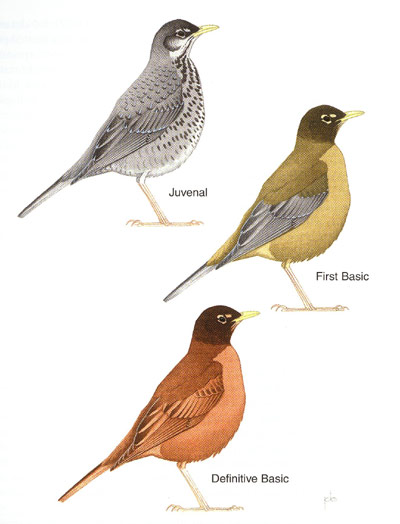
Figure 3: Male American Robin: example of species having one molt per year (cycle) after juvenal plumage. First basic acquired by partial molt; retained juvenal feathers shown in gray. Definitive basic acquired by complete molt. First basic and definitive basic plumages are very similar in robins but careful examination will separate most birds. See Pyle (1997) for details.
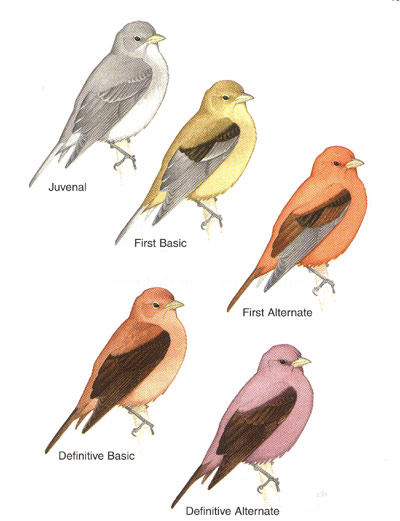
Figure 4: Male Scarlet Tanager: example of species having two molts per year (cycle) after juvenal plumage. First basic acquired by partial molt; retained juvenal feathers shown in gray. First alternate acquired by partial molt; retained juvenal primaries/secondaries shown in gray. Definitive basic acquired by complete molt. Definitive alternate acquired by partial molt. See Pyle (1997) for details. For actual colours, see Peter Burke's illustrations on page 393 in third or fourth editions of the National Geographic Guide (1999 or 2001). Juvenal plumage of Scarlet Tanager is not illustrated in NGG.
Comparison of Plumage and Molt TerminologiesTop
The two charts below compare the names of plumages and molts in general use with those of Humphrey and Parkes. Separate sequences are shown for birds that molt once a year in Chart A and twice a year in Chart B. The names of molts are marked this way.
Plumage and Molt Sequences for:
Chart A: Birds that molt once (1x) a year
General Terms | Humphrey and Parkes Terms |
|---|---|
juvenile plumage | juvenal plumage |
postjuvenile molt | first prebasic molt |
first year plumage | first basic plumage |
adult postbreeding molt | definitive prebasic molt |
adult plumage | definitive basic plumage |
Chart B: Birds that molt twice (2x) a year
General Terms | Humphrey and Parkes Terms |
|---|---|
juvenile plumage | juvenal plumage |
postjuvenile molt | first prebasic molt |
first winter plumage | first basic plumage |
first prebreeding molt | first prealternate molt |
first summer plumage | first alternate plumage |
adult postbreeding molt | definitive prebasic molt |
adult winter plumage | definitive basic plumage |
adult prebreeding molt | definitive prealternate molt |
adult breeding plumage | definitive alternate plumage |
Most birds, whether they molt once or twice per cycle (year), acquire their first definitive basic plumage in late summer or early fall of their second calendar year, when they are just over a year old. For most species that molt twice per cycle, they acquire their first definitive alternate plumage in late winter or spring of their third calendar year, somewhat before two years of age. Definitive plumages are repeated for the life of the bird. Additional molts and plumages can be added for species that take longer to reach definitive plumage. Presupplemental molts and supplemental plumages also can be inserted into the above sequences.
RecommendationsTop
1. In your field guide, write the number 1 or 2 beside the birds that have either one or two molts per year. This is the key to knowing if a bird has only a basic plumage or both basic and alternate plumages.
2. Label the birds in your field guide, using the Humphrey and Parkes terminology. For example, Basic I, Alt. I, Def. Basic, Def. Alt., etc.
3. Practice looking closely at photographs of birds in books. Try ageing and assigning plumages and molts by looking for different feather generations, and signs of molt and wear.
4. Check out the selected references below. If you want to know more, request the cited papers and books from a library.
5. Get out in the field and study the common birds more closely. It takes work, but you will soon expand your knowledge and understanding.
AcknowledgementsTop
I thank Peter Burke, the late Earl Godfrey, Michel Gosselin of the Canadian Museum of Nature, Jean Iron, Alvaro Jaramillo, Michael King, Kevin McLaughlin and Ron Tozer for their valuable assistance. Peter Burke kindly prepared the illustrations. David Cattrall kindly set up this article on the OFO Web Page.
Literature CitedTop
1959. An approach to the study of molts and plumages. Auk 76: 1-31. It is highly recommended for the advanced birder, but requires several readings.
1974. The Bird Life of Texas. Volumes 1 and 2. University of Texas Press, Austin, Texas. It provides extremely detailed plumage descriptions. It is like having the bird in the hand and is highly recommended.
1962, 1976, 1988. Handbook of North American Birds. Volumes 1 to 5: Loons through Diurnal Raptors. Yale University Press, New Haven, Connecticut. These volumes contain some of the best information available on North American birds. The Humphrey and Parkes plumage and molt terminology is used.
1997. Identification Guide to North American Birds. Part 1. Slate Creek Press, Bolinas, California. The most authoritative guide to plumages, molts, ageing and sexing birds in the hand and in the field. Pyle uses an interesting and effective combination of banding codes and traditional terms, mixed with the terminology of Humphrey and Parkes (1959).
1989. The terminology of plumage and molt. Birding 21: 148-154. This is one of the best articles written for birders on using plumage and molt terminologies. It strongly endorses the Humphrey and Parkes terminology.
